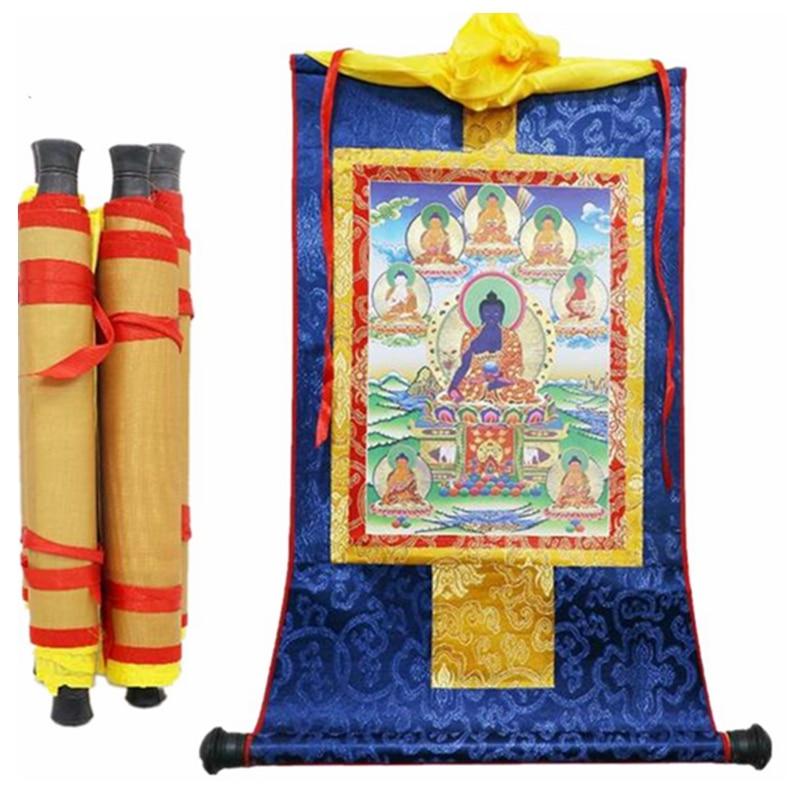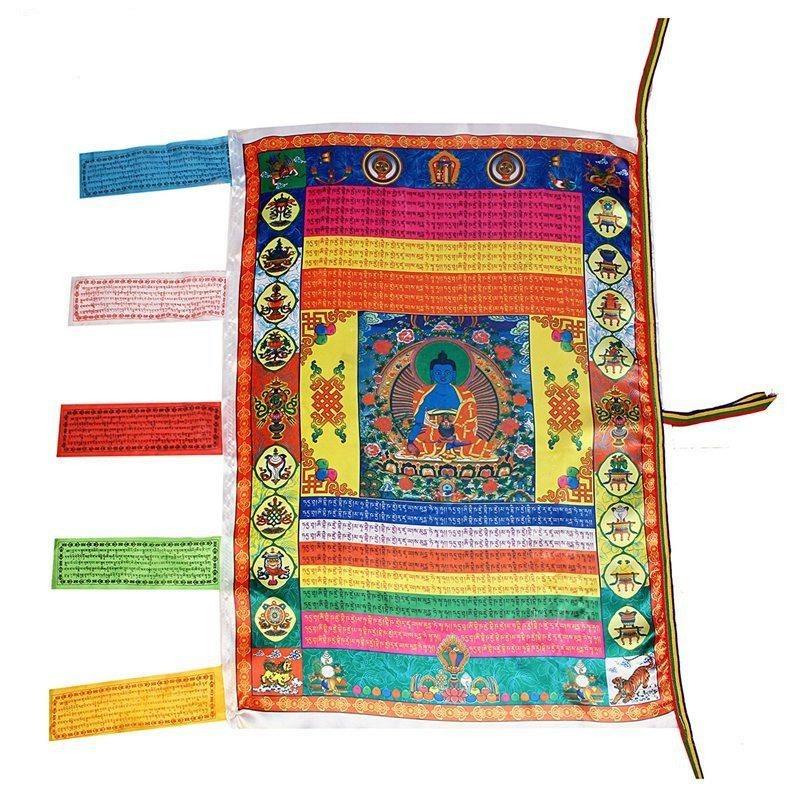The Tibetan Thangka, a Great Buddhist Meditation Tool
We refer to Tibetan paintings made from mineral pigments placed on cotton or silk canvases as “thangka”.
If we are talking to you about it today, it is quite simply because the Tibetan thangka is one of the main meditation tools in Buddhism.
We know it poorly in the West. Its effects on our karma, its link with the principles of dharma and the quest for nirvana are nevertheless very real.
In short, we will dissect the subject together.
Contents :

But actually, what is a “thangka”?
In Tibetan, “thangka” literally means “message that is recorded”.
This already shows us the primary purpose of these paintings: to convey messages to men.
Yes, thangkas are often designed with the aim of communicating with the practitioner who will look at it or, better yet, meditate on it in a monastery.
You should know that historically, this type of Tibetan painting was created by monks to transmit the teachings of Buddhist philosophy to the population.
Over time, some also realized that there were patterns and symbols (arguably more sacred than others) that brought certain blessings to those who looked at them.
Certain Tibetan thangkas are, in this sense, real lucky paintings! Buddhist tradition attributes to them qualities of compassion, benevolence, spiritual awakening and many others.
These very special symbols have the chance to be very diverse, which allows us to create paintings for everyone, and for all tastes.
Concretely, whether you prefer a traditional figure of the Buddha in full meditation, ancient Tibetan drawings or, on the contrary, other more contemporary ones, you will find a thangka made for you.
One thing, however, will remain constant: the desire to transmit Buddhist history and principles. One deity will be more esoteric than the others, and one principle of tantra will require additional explanations. Tibetan thangkas will be there to illustrate what cannot be said.
As we told you, these works are created by monks practicing Vajrayana Buddhism. We are therefore talking here about religious works of art.
Immemorial Buddhist myths and legends, representation of Buddhas (because, yes, there are several), gods or demons of Asian mythology: all this smells like a journey... and takes us on a journey!
History and origin
No one knows precisely where and when Tibetan thangkas originated.
However, historians agree that they appeared in Tibet (as you might have guessed), during the Tubo period (around the 7th century).
By combining the techniques of Chinese scroll painting, silk weaving and traditional Nepalese painting, certain communities of monks have been able to create simply exceptional art.
For the record, it was when King Songtsen Gampo (who you can find more information about here ) married a princess from Nepal known as Chizun and another from China (yes, polygamy was common in the Himalayas at that time) that the links between these three cultures were truly united.
Each of the two princesses actually came to the king's court with writings, knowledge, sages and a whole court of servants who, exchanging together, made Tibet rich for several centuries.
Which goes to show that the history of thangka is also that of science, exchanges between cultures and the circulation of knowledge!
In short, we now know what could have allowed the thangka to be born... but ultimately, why this form of canvas and not another?
The answer to this lies once again in the history of Tibet.
At that time (in the 7th century), only a few monks were literate and, apart from oral transmission, there was a lack of means to transmit Buddhist principles and teaching to the population.
It was therefore necessary to find a visual but above all transportable way to communicate with as many people as possible. For this, paints on lightweight, easily rollable rollers were ideal.
However, transport tended to damage the paints and erase the lighter pigments. It was therefore necessary to use intense colors made to last.
You will have understood: the thangka tradition was born.
Over the centuries that followed (and particularly the period of the Ming dynasty), this traditional art developed and conquered the whole of Tibet, then neighboring countries, even reaching the palace of the Chinese emperor!

Thangka as a meditation tool
Thangkas are overflowing with symbolism and more or less hidden religious messages.
At first glance, we could say that these paintings serve (as is the case historically) to teach the life of the Buddha, to describe certain historical events or to transmit the Buddhist tradition and myths of the region... and that is indeed the case.
Tibetan thangkas, however, have other astonishing abilities that it would be foolish to ignore.
These canvases are actually used for their mystical nature in a whole host of rituals, ceremonies, and ritual prayers.
Closer to us, it is also possible to meditate on thangkas (not while sitting on them, you understand). Those who have tried it have spoken of greater ease in entering trance states, a feeling of progress toward enlightenment, and greater harmony with the Buddha's message.
Also note that Tibetan Buddhist monks believe that meditation accompanied by thangkas improves karma and merits.
According to this idea, the paintings we are talking about would help us in a much more concrete way, almost physical in reality, than we might think...
Interesting.
In short, all this is in fact made possible by respecting very strict rules and codes.
Because thangka creation is primarily a religious act, everything on it (characters, symbols, and even simple shapes) must conform to Tibetan Buddhist traditions.
There is even a real “thangka guide” that monks must follow and which precisely describes the right ways to proceed.
Take for example this thangka from Bhaishajyaguru, or this one supposed to represent the same character.
They have different symbols, and the effects they will have on those who delve into them will also differ. However, their goal will remain the same: to bring us the blessings specific to a figure of Tibetan Buddhism.
Different types of Tibetan thangkas
You will have understood: thangkas constitute a very old form of art and, above all, which was very popular in Asia.
All this led to numerous variations and paintings that were sometimes very different from each other.
As such, we would like to raise two points in particular.
Different sizes
Yes, although traditional thangkas are all more or less the same size (approximately 40 to 80 cm in length), today there are much more varied models.
For example, we can find much, much (but then much) larger thangkas.
We are talking here about paintings more than 20 m wide and a good centimeter thick.
Absolutely magnificent, these “thangkas among the thangkas” are only brought out for the most important holidays. For example, take a look at this article from a Belgian newspaper which talks about an impressive painting unveiled for the New Year in Tibet.
When we think about it, these gigantic paintings have undoubtedly lost their primary purpose, namely to be easily transportable in the mountains.
The fact remains that they have retained their sacred and religious character.
Various and varied materials
We vaguely mentioned it at the beginning of the article: thangkas are generally made from silk or cotton.
Obviously, given the fragility and rarity of these two materials, one will be intended for “general public” thangkas while the other will be reserved for monks, nobles, rich merchants… in short, for a small caste.
In addition to the material, we can also classify Tibetan thangka into two distinct quality categories: painted thangkas and embroidered thangkas.
While the former are painted in the same way as the paintings we are used to seeing, the latter first see their threads colored by pigments so that only then are they woven to form the canvas.
Concretely, this second technique requires much more technique, time... and therefore money. It is therefore important figures (such as the Dalai Lama or heads of state) who will be able to benefit from the most richly decorated thangkas.
Lucky charms featured in this article

Thangka of 8 Bhaishajyaguru
See more
Flag of Bhaishajyaguru of Medicine
See more


